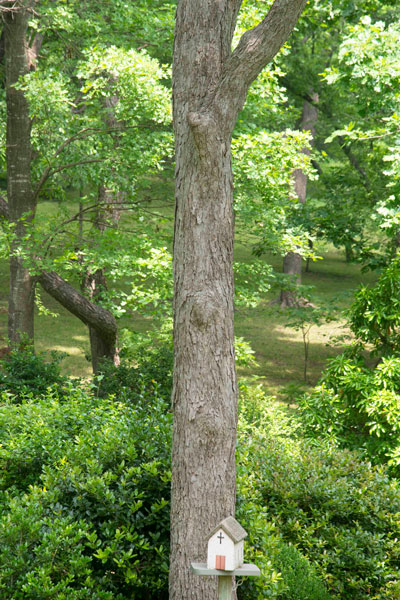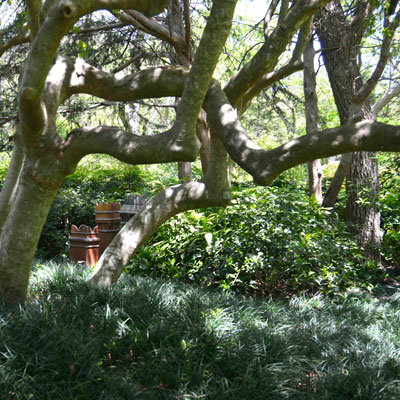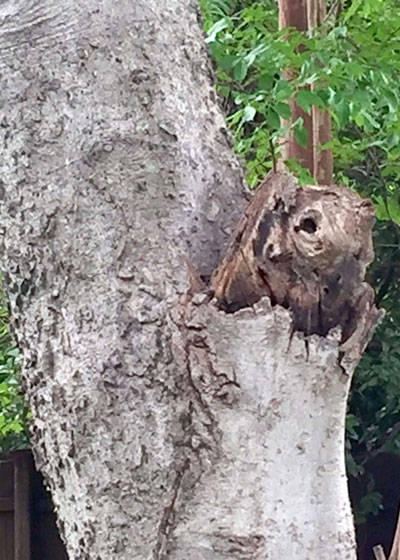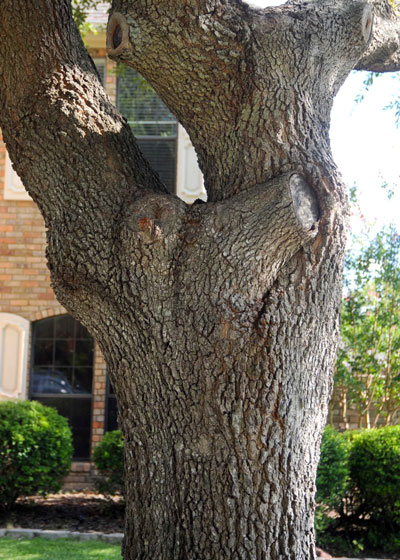Prune Properly, Avoid Problems
The old slogan with serious tree people is always to “Prune with a Purpose.” Know why you’re pruning, and know how best to do it. I can’t make you an expert in one short story here, but I can give you some quick tips and pointers to pruning your trees.

Photo: Tall pecan in Sperry backyard has been pruned several times over the past 20 years by certified arborists of Arborilogical Services. Note how well the wounds have healed.
Time of year…
Most trees can be pruned at any time of the year. It’s easier to see a tree’s branch structure while it’s bare in the winter, so I like to prune at that time if I possibly can. However, professional arborists stay busy 12 months a year.
Oaks are the exception to year ‘round pruning, and that’s because of the oak wilt fungus. Its fungal mats are active in springtime, so oaks must not be pruned (unless it’s an emergency) from mid-February through mid-July. All oak cuts should be sealed with black pruning paint immediately after the cut has been made.
Dead and damaged branches should be removed as soon as they are observed. Leaving them in place risks the development of decay, and it also brings the possibility that they will break and fall.
Large limb removal…
Use the three-step technique of removing branches greater than 2 or 3 inches in diameter. If you have ever cut a 2×4 or other heavy board on sawhorses, you know how the weight of the board will cause it to break and peel back just before it falls. To a branch with significant weight, that peeling can reach the main trunk and it can do serious damage peeling bark down the trunk. Follow these guidelines:
Step 1. Go out 10 or 12 inches from the main trunk and make an undercut one-fourth of the way into the bottom of the branch. Don’t cut too far or the weight of the branch will cause the branch to bind your blade.
Step 2. Come 2 or 3 inches farther out from the trunk and cut completely through the branch from the top down. The weight of the falling branch will cause the limb to split back to your undercut.
Step 3. Make your final cut relatively flush with the main trunk. The stub you’re removing shouldn’t weigh enough to cause any splitting. Leave just a small section of the branch collar for the fastest possible healing.
Critical Note!
Do not attempt to remove branches more than a few feet off the ground on your own. Do not climb on trees to make cuts. Do not rest your ladder against trees. In fact, it’s best not to bring a ladder out to the tree at all, and never lift your chain saw above shoulder level. Too many gardeners have been hurt while pruning their trees. Trained and certified arborists have the knowledge of how to do the job safely and without damage to your home or landscape.
Why the branch collar matters…
Think of the delta of a river, where it enters the sea. Think about how it broadens out at that delta, becoming much wider than it is just a few miles upstream. If you wanted to build a bridge over that river, but you needed to be as close to the coast as you could, you’d build it just a short bit upstream, not over the delta.
When you remove a branch, you want to think about where that bridge would be built. Go back just a little ways on the branch – probably only 1/4- to 1/2 inch from the trunk. Rather than cutting through the branch flush with the main trunk (at the delta), come back that short distance. That will do an effective job of removing the branch, but it will leave a much smaller wound across which the tree will form its new bark.

Photo: This branch has been perfectly pruned from a Chinese pistachio tree. Notice how well the roll of new bark is forming across the wound. Soon it will be entirely healed.

Photo: A yaupon holly in the Sperry landscape pruned by certified arborists. Notice that the branch collars do extend out just a short bit from the “elbows” of the branches. They have healed perfectly in the six or seven years since this pruning was done.

Photo: This hackberry was never pruned after one of its major branches broke in a storm. The tree has been unable to heal across the wound. Decay is setting in, and soon the entire tree will be lost.
About pruning paint…
I mentioned the importance of sealing all cuts made to oak trees at any time of the year to reduce your chances of having oak wilt invade them through the open wounds. However, research has shown that other tree species actually heal more quickly if no sealant is used.
How to find a certified arborist…
The International Society of Arboriculture is a worldwide organization formed in the interest of highest quality tree service. Don’t be afraid to ask any tree specialist if he or she is a “certified arborist.” Use that specific term, and then verify it through the ISA website. Here is a link to assist you in finding certified arborists in or near your Zip Code and to verify certifications as well. There will be more certified arborists near major urban areas, of course, but this can be a starting point. Local garden center owners and managers will usually know the best tree people around, so ask their advice as well.

Photo: Here’s how you should NOT prune your trees. This elongated stub will never heal. The tree will grow around it, and a weakened area will develop.
